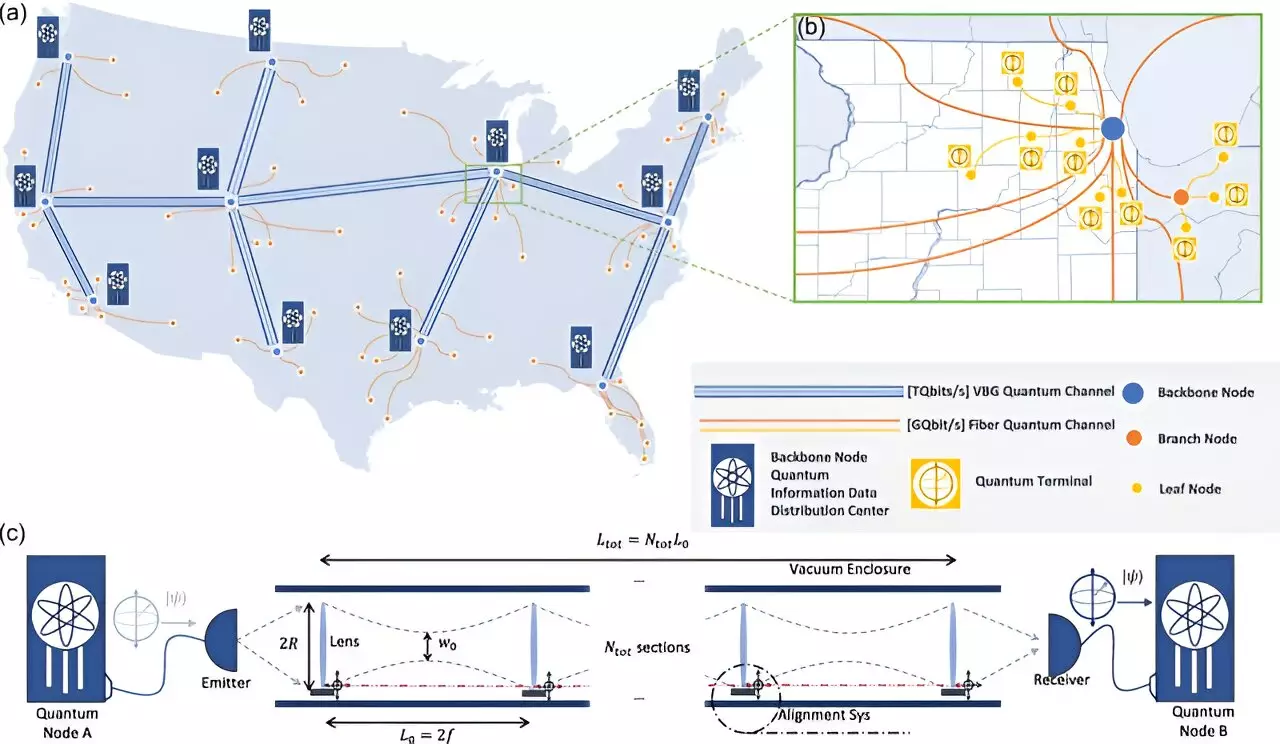As we step into a new era of computing, quantum technology stands at the forefront, heralding the dawn of unparalleled advancements across various fields, including cybersecurity, communications, and data processing. The potential of quantum computers is vast; however, the realization of this potential hinges on a fundamental challenge: creating an interconnected network of quantum computers akin to a quantum internet. The idea is not just to connect isolated quantum devices, but to engineer a robust network capable of securely transmitting quantum information over long distances. Recently, researchers at the University of Chicago Pritzker School of Molecular Engineering have offered an innovative blueprint that could pave the way for this dream to become a reality.
Groundbreaking Vacuum Tube Technology
The research team has proposed an intriguing method leveraging vacuum-sealed tubes equipped with an array of precisely positioned lenses to transport quantum information. These vacuum beam guides, measuring approximately 20 centimeters in diameter, promise to span thousands of kilometers while accommodating a staggering capacity of over 10 trillion qubits per second—far surpassing existing quantum communication methodologies. The technique centers on the transmission of photons, which encode quantum data, through these tubes. By employing lenses strategically situated within the pipeline, the photons can maintain focus, ensuring that the integrity of the quantum data remains intact even over long distances.
This leap forward in quantum telecommunications could fundamentally transform the landscape of secure communication and enable novel applications such as distributed quantum computing networks, innovative sensing technologies, and synchronized timekeeping systems. The collaborative efforts of Professor Liang Jiang and his colleagues affirm the viability of this network framework, suggesting that it could reshape the paradigm of how we understand and utilize quantum mechanics in practical applications.
The Quantum Advantage: Beyond Classical Limitations
To grasp the implications of these advancements, it’s crucial to understand how quantum computers differ fundamentally from their classical counterparts. Classical computers operate on binary bits, represented as either a 0 or a 1. Conversely, quantum computers exploit the unique properties of qubits, which can exist simultaneously in multiple states—a phenomenon known as superposition. Furthermore, they harness entanglement, wherein pairs of particles become intertwined in such a way that measuring one instantly impacts the other, regardless of the distance separating them. These properties grant quantum computers extraordinary capabilities in data analysis and secure information transmission.
The potential for connecting multiple quantum computers presents a compelling case for pooling their considerable data processing capabilities. However, conventional networking techniques fall short in preserving the quantum properties of qubits, posing a significant challenge for the integration of quantum devices. Professor Jiang aptly points out that relying on classical networks for transmitting quantum states is fundamentally inadequate, as this approach leads to the degradation of quantum information, rendering it less secure and efficient.
From Theory to Application: The LIGO Inspiration
The inspiration for these revolutionary vacuum tubes can be traced back to cutting-edge experiments conducted by the Laser Interferometer Gravitational-Wave Observatory (LIGO) at Caltech. By constructing extensive vacuum tubes to facilitate the detection of gravitational waves, LIGO has demonstrated the remarkable capacity of photons to traverse vast distances in a near-molecule-free environment. However, unlike LIGO’s ultra-high vacuum conditions, the new research suggests a more manageable medium vacuum pressure, making it more feasible for practical applications on a broader scale.
The main technical hurdle identified by Huang and Jiang revolves around the diffraction of photons as they extend through the vacuum channels. Their proposed solution—intervening lenses placed strategically along the tube—ensures that the beam remains focused and diminishes losses associated with photon spreading. This innovative approach underscores a critical aspect of quantum technology’s advancement: marrying theoretical concepts with practical engineering solutions to carve pathways for real-world application.
The Future Landscape of Quantum Communication
As researchers embark on constructing tabletop experiments to validate their theoretical proposals, the implications for future quantum networking could be profound. Extending the capabilities of vacuum tube technology from experimental concepts to working systems involves a multifaceted challenge reminiscent of the historical advancements that propelled the internet into ubiquity.
Civil engineering challenges will inevitably arise, necessitating innovative infrastructural designs and new standards for telecommunications. Nevertheless, if these can be surmounted, the results may not only bring about a new dimension in cybersecurity but also empower emerging technologies across healthcare, finance, and artificial intelligence. The envisioned quantum internet promises a transformative landscape, safeguarded by the unparalleled security features inherent to quantum mechanics. As these pioneers of quantum engineering push forward, we may soon witness the unfolding of a technological frontier limited only by imagination.

